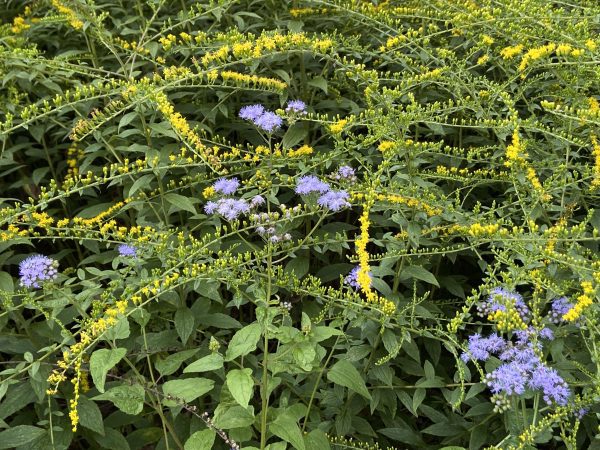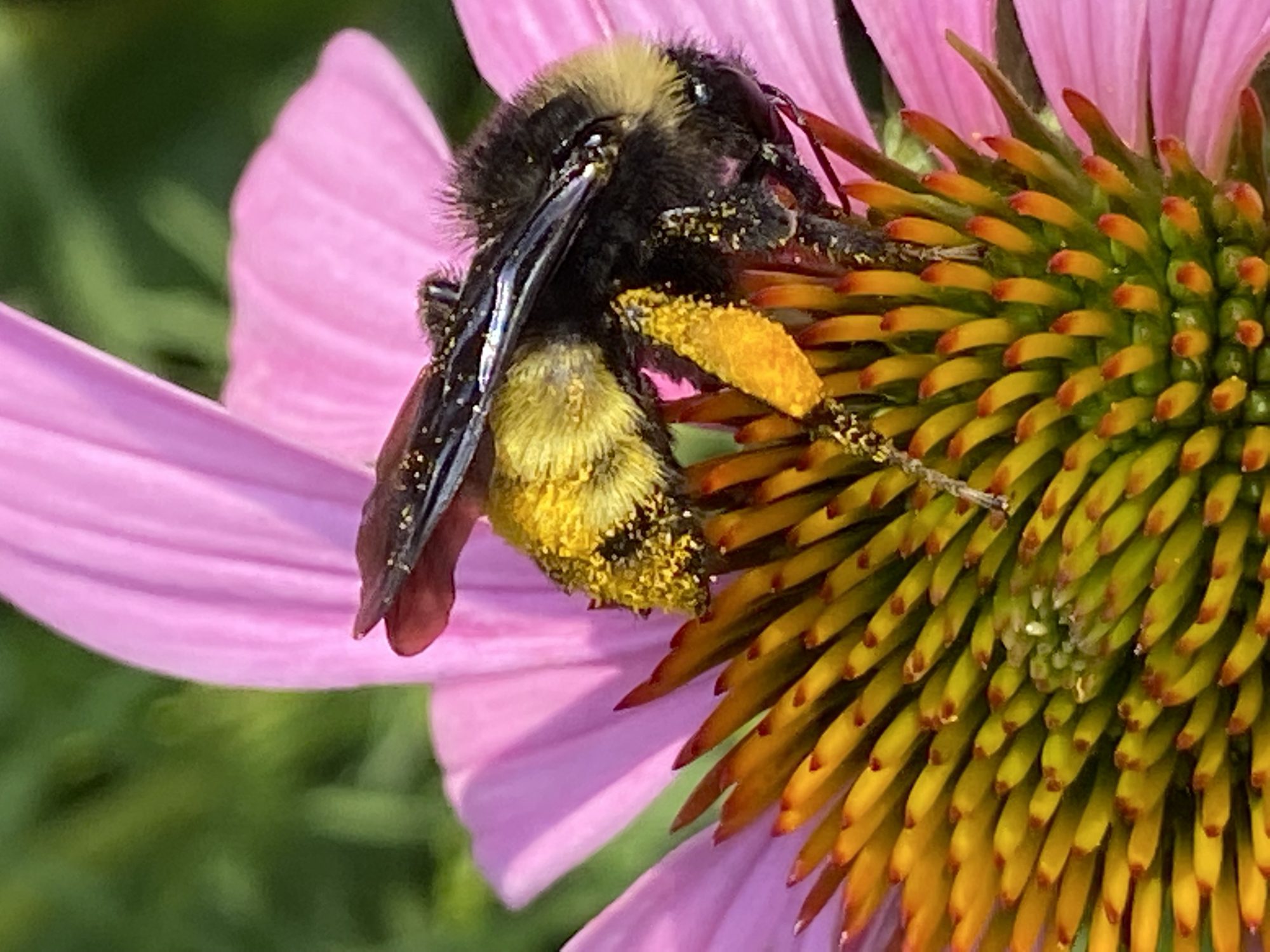Native plants for native bees in the Charlotte region

A flower bed might have a vibrant assortment of blossoms, but without the movement and sparkle of pollinators, it can seem flat and static. It’s been a bad year for butterflies in my garden, and I’ve heard similar reports from across the Piedmont. Their numbers seem to be down. Their absence has made me even more grateful for the native bees I’ve managed to attract with my plantings.
My heightened appreciation also comes from participating in the Great American Bee Count project on iNaturalist and the Bee Short Course for Community Scientists, an online lecture series from Ohio State University.
In Bee Botany 101, Randy Mitchell, a biology professor at the University of Akron, explained the relationship between bees and flowers. Bees need the pollen, nectar, resins and oils. Flowers need to have their pollen redistributed to prevent inbreeding depression. While the relationship is mutually beneficial, there’s also a tension. Flowers don’t want to be robbed of all their pollen, and bees don’t care if they move it around.
“Plants have lots of features that optimize their end of the tension,” Mitchell said. “But a balance is usually reached.” The shape of the flower will determine how a bee interacts with it.
Roughly a quarter of the bees in the Eastern US are pollen specialists, meaning they depend entirely on a single species or genus. According to a recent article by Jarrod Fowler and Sam Droege, Pollen Specialist Bees of the Eastern United States, North Carolina leads the region with 142 pollen specialists, or 28% of our native bees. Most are rare to uncommon, but one of the few common species targets spring beauties, among the first wildflowers to bloom in Piedmont forests each spring. These tiny flowers can be easily overlooked, but the equally tiny Andrena erigeniae bee somehow manages to find them.
Most bees are generalists to some degree, but even they still exhibit clear preferences for certain flowers. Mitchell highlighted four families that are especially important to our native bees.

An American Bumblebee probes a coneflower’s individual florets. Photo: Ruth Ann Grissom
Rosaceae
Members of the rose family have flowers with five petals shaped like a shallow bowl. Mitchell calls the familiar hybrid tea “a dreadful perversion.” They’ve been bred to please humans, not bees. They have too many petals, making the anthers inaccessible to pollinators. In a native rose, bees are able to easily wander around a big, open flower, sweeping up pollen.
Lamiaceae
The mints are generally tubular, requiring most bees to extend its tongue deep into the flower to procure the pollen. Some even have a specialized lever that pops down on the bee’s back and brushes it with pollen.
Fabaceae
Flowers of plants in the pea or bean family will be familiar to anyone who has a vegetable garden. These beautiful flowers are composed of specialized petals – the banner, wings and keel. The bee, attracted by the banner at the top, pushes apart the two wings on the sides and then depresses the keel at the bottom to make the pollen accessible.
Asteraceae
The asters, including the beloved sunflowers, are sometimes called composites — what appears to be a single flower is actually made up of many florets. The bees treat them as such, crawling around probing each one individually. This creates multiple sources of pollen in close proximity – how convenient for the bees!
If a gardener wanted to focus on a single family, Gabriela Garrison, Eastern Piedmont habitat conservation coordinator with the N.C. Wildlife Resources Commission, would recommend the asters. They attract a wide range of bees, in part because they can provide pollen for so much of the year. In the Piedmont, it’s easy to have members of this family in bloom from April through November.
Garrison notes that while bees might collect pollen from exotic flowers such as zinnias, many rely on native vegetation for nesting. To have healthy bee populations, it’s important to consider their needs throughout their entire life cycle. As a bonus, what’s good for the bees is also good for the birds. As I type these words, I’m distracted by the goldfinches plucking seeds from my purple coneflowers. The flowers are spent, but the brown seed heads still attract flashes of color to the garden.
While we can’t underestimate the value of protecting and restoring habitat in our parks and natural areas – think of the specialized relationship between spring beauties and the Andrena erigeniae bees – gardeners have the power to supplement those efforts by adding high value plant species to our own yards.
Here’s a list of pollinator magnets that perform well in my sunny Piedmont garden.
The Roses
- Swamp rose
- Black cherry
- Red chokecherry
The Mints
- Bee balm
- Mountain mint
- Obedient plant
The Peas
- Red bud
- Baptisias
- False indigo shrub
The Asters
- Coreopsis
- Purple coneflower
- Brown-eye Susan
- Joe Pye weed
- Ironweed
- Cutleaf coneflower
- Goldenrod
- Blue mist flower
- Aromatic aster
- Frost aster
My Favorites from other Families
- Carolina jessamine
- Culver’s root
- Rattlesnake master
- Lobelia
- Garden phlox
- Blueberries
- St John’s wort
The North Carolina Wildlife Federation North Carolina Native Pollinator Perennial and Annual Flowers has a curated list of suggested plants with photographs and helpful descriptions.
The North Carolina Pollinator Conservation Alliance (www.ncpollinatoralliance.org) has many additional recommendations.
Many of these species will be available at the upcoming plant sales at the UNCC Botanical Gardens Botanical Gardens | Fall Plant Sale (charlotte.edu) (September 30-October 2) and Wing Haven Happenings: Plants Sales — Wing Haven (winghavengardens.org) (October 13-16).
Uwharrie Mountain Native Plant Farm in Biscoe also has a great selection. This nursery is open by appointment only. Contact them at (910-975-2373) or uwharrienatives@yahoo.com.